-

-
We are specialists for your holidays in La Palma. With personalized assistance on-site.

Ulrich & Evelyn Roth -
Our service numbers
Write e-mail+34 822 68 00 89
+49 7442 819 85 90
We're available from Monday to Friday from 10:00 a.m. to 6:00 p.m., and Saturdays from 10:00 a.m. to 1:00 p.m.
-
Accommodations
- with pool 90
- on the seaside 42
- with internet 205
-
Northwest >>
130
- Aguatavar 7
- Arecida 6
- El Castillo 1
- Garafía 4
- Las Tricias 7
- Puntagorda 42
- Tijarafe 22
- Tijarafe Costa 6
- Tijarafe El Jesús 12
- Tijarafe La Punta 21
- Tinizara 2
-
Aridane Valley >>
225
- Celta 7
- Charco Verde 3
- El Paso 23
- Hermosilla 1
- La Bombilla 2
- La Laguna 11
- Las Manchas 24
- Las Norias 11
- Los Llanos de Aridane 25
- Puerto de Naos 45
- San Nicolas 8
- Tacande 2
- Tajuya 9
- Tazacorte Costa 5
- Tazacorte Puerto 14
- Tazacorte Villa 23
- Todoque 12
-
South >>
31
- Fuencaliente 7
- Las Indias 4
- Lomo Oscuro 1
- Los Quemados 6
- Salemera 2
- Tigalate 2
- Villa de Mazo 9
- East >> 16
-
Northeast >>
5
- Barlovento 2
- Los Sauces 2
- Puntallana 1
Native Inhabitants of La Palma
Benahoaritas
Before Spanish conquerors in 1493 finally took over "San Miguel de La Palma“, the native Benahoaritas, also called Auaritas or Awaras, had already lived on the island.

However, the ancient inhabitants of the Canary Islands were referred to as "Guanche“, but local people called their island „benahoare“, where its name derives from.
Who were those people, for how long did they live there and where did they come from?
Lying in the north-western part of the Canary islands, La Palma is situated far in the Atlantic Ocean. Mainland is within a distance of 1.400 km, Africa is 400 km away and closer to La Palma.
Steady settlement on the island took place about 400/300 B.C. Supposedly, the inhabitants who encountered Alonso Fernández de Lugo and his soldiers, originally came from North Africa. However, nobody knows it for sure.

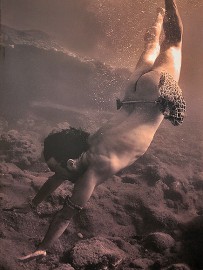 This much is certain: the Benahoaritas lived in natural caves where they also stored their provisions.
This much is certain: the Benahoaritas lived in natural caves where they also stored their provisions.
Climate and supply of water undoubtedly played a major role in the selection of the location in Barrancos, near the coast or in the mountain regions.
A few discovered remains proofed that at places with no caves available there were also stone dwellings..
Some caves were used as burial places. The Benahoaritas were aware of the mummification, which they probably used for kings or other eminent persons with a special social status.
In the endless vast of the Atlantic Ocean People were exposed to Mother Nature's Caprices
 The rhythm of sun, rain and snow not only meant life but mostly surviving.
The rhythm of sun, rain and snow not only meant life but mostly surviving.

It was no surprise, that the native inhabitants of La Palma worshipped the earth and the sky. Special landmarks like the Roque Idafe in the Caldera de Taburiente were their iconic sites and sanctuaries.
The sky with its striking luminaries was the kingdom of the goddess “Abora”, the sun, and its counterpart "Iruene", the moon.
Iruene is also described as a dog-like, feared demon, which might result in the big,, shaggy-looking dogs, that attached the herd of cattle at night (Fray J. Abreu Galindo, 16. Jh.).

The Benahoaritas were said to be peaceful people

They bred goats, sheep and pigs.
In search of grazing grounds shepherds together with their herds climbed the highest peak.
The animals' furs were worked into clothing and bones into tools. Furthermore, they used stones, fish bones, plant parts and wood for the manufacture of their utensils.

Meat and milk were main food components and there were also fish, seafood, wild plants and a small amount of grown barley, wheat and legumes.

Grain was grinded by hand into flour and after roasting into Gofio. This typical Canary staple food to this day has remained popular.
 Traditional pottery sherds were found at many excavation sites.
Traditional pottery sherds were found at many excavation sites.
They had all been crafted without any pottery wheel and can be assigned to different periods.
The dark colour and elaborately engravings are remarkable.
During the "Conquista" the island was divided into 12 territories.
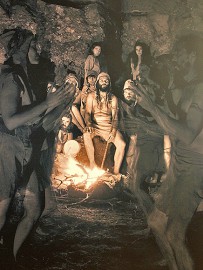
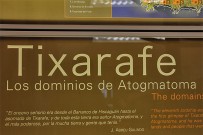 Each was ruled by a one or more chiefs or kings.
Each was ruled by a one or more chiefs or kings.
They were called “mencey”.
The pre-historic designation and distribution partially has still remained in the territories of the districts:
- Aridane (Los Llanos de Aridane, El Paso, Tazacorte),
- Tijuya (Tajuya, Todoque, Puerto Naos, La Laguna and a part of Las Manchas),
- Tamanca (part of Las Manchas),
- Ahenguareme (Fuencaliente),
- Tigalate (Mazo),
- Tedote (Santa Cruz de La Palma, Breña Alta, Breña Baja),
- Tenagua (Puntallana),
- Adeyahamen (San Andrés y Sauces),
- Tagaragre (Barlovento),
- Tagalguen (Garafía),
- Tijarafe (Tijarafe and Puntagorda),
- Aceró (Caldera de Taburiente)
Spanish Conquistadores did not have much in mind with the Benahoaritas
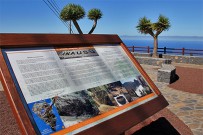
 Without greater resistance, they forcibly seized almost the entire island.
Without greater resistance, they forcibly seized almost the entire island.
Only the famous Taunausú and some other combatants made a stand against them battling from the Caldera de Taburiente. Until they were defeated by a perfidy.
Tanausú was taken prisoner and carried on Spanish ship.
He should be taken to the Spanish mainland, maybe sold as a slave. However on the way there shouted „vacaguaré“ ("I want to die"), refused to eat and died during the passage.
On the island Alonso Fernández' men killed or enslaved most of the old Canary people
Survivors had to bow down to Spanish conventions.

 Most of them mixed with the new inhabitants, their faith and language almost got completely lost. The Benahoaritas did not know any writing, however, many stones and rock faces were marked with uninterpretable signs - the petroglyphs.
Most of them mixed with the new inhabitants, their faith and language almost got completely lost. The Benahoaritas did not know any writing, however, many stones and rock faces were marked with uninterpretable signs - the petroglyphs.
During the long period of the native settlement until the takeover of Spanish conquistadors in the 15th century a large number of engravings, channels, ditches and basins emerged. Geometric forms like circles, spirals, meander or lines appear either separate or devoured showing complicated patterns.
 No one ever made any effort and tried to get to the bottom of the messages set in stone.
No one ever made any effort and tried to get to the bottom of the messages set in stone.
Their meaning has remained unclear to this day. Apart of speculations being magic-religious ones, marks for grazing land, water places, paths and other things of everyday life, it is almost certain, that some cult sites refer to the summer or winter solstice.

 Caves used by the native inhabitants were also taken in possession of the new rulers of the island.
Caves used by the native inhabitants were also taken in possession of the new rulers of the island.
Traces of the ancient folk was almost completely wiped out. For centuries there was no interest in the former inhabitants of La Palma. Probably the new settlers wer too busy with themselves.

They also came from different countries and had to get used to their new homeland and work hard to turn the initially wild island in a productive land.
Generation after generation baskets, shards, bones and other material swept down from the caves into canyons, in order to accommodate their cattle and provisions. Even when building their houses they did not refrain from using stones with engravings.
It was not until 1752 that Domingo van de Walle discovered the first Petroglyphs on La Palma
 The archaeological find in the Caves of Belmaco (Mazo) had been the first of its kind on the Canary Islands.
The archaeological find in the Caves of Belmaco (Mazo) had been the first of its kind on the Canary Islands.
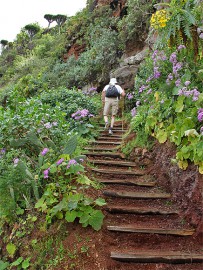
However, public interest in the native inhabitants of La Palma arose only in the 1980s.
Meanwhile, hundreds of excavation sites are known on La Palma.

A large number of archaeological, historical, ethnographic and other researchers as well as a archaeastronomic group tried to find out more about the mysterious heritage of the Benahoaritas (Guanchen) and their lifestyle.



photos: Ines Dietrich, Uka Rösch, some photos were taken at the MAB - Museo Arqueológico Benahoarita in Los Llanos



Das ist sehr interessant, ich möchte gern mehr über die Ureinwohner erfahren.
Soy cubano, decendiente de canarios (de La Palma y Gran Canaria). Jamas habia sabido nada sobre este aspecto de mis raices, que aunque tanto españolas como portuguesas y francesas, muy probablemente tengan algo de aborigen tambien.
Muy buen artículo. Muy corto pero muy bien sintetizado.
Genial artículo
Muy interesante, amena la lectura